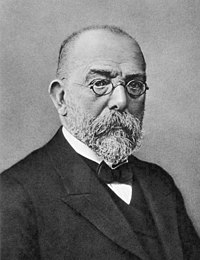Koch's postulates
four criteria showing a causal relationship between a causative microbe and a disease
Koch's postulates are four ideas about the relationship between a microbe and a disease.

The postulates were made by Robert Koch and Friedrich Loeffler in 1884, based on earlier ideas of Jakob Henle.[2] They were refined and published by Koch in 1890.
Koch applied the postulates to cholera and tuberculosis, but they have been used for other diseases. These postulates were made before viruses were discovered. Also, they did not realise that some people were "asymptomatic carriers": they could carry the disease without showing signs of it. The postulates are little used today. Other criteria are used, for example the Bradford Hill criteria for infectious diseases in modern public health.
Koch's postulates:
References
change- ↑ Koch, R. (1876). "Untersuchungen über Bakterien: V. Die Ätiologie der Milzbrand-Krankheit, begründet auf die Entwicklungsgeschichte des Bacillus anthracis" [Investigations into bacteria: V. The etiology of anthrax, based on the ontogenesis of Bacillus anthracis] (PDF). Cohns Beitrage zur Biologie der Pflanzen (in German). 2 (2): 277–310.
- ↑ Evans A.S. (October 1978). "Causation and disease: a chronological journey. The Thomas Parran Lecture". American Journal of Epidemiology. 108 (4): 249–58. doi:10.1093/oxfordjournals.aje.a112617. PMID 727194.